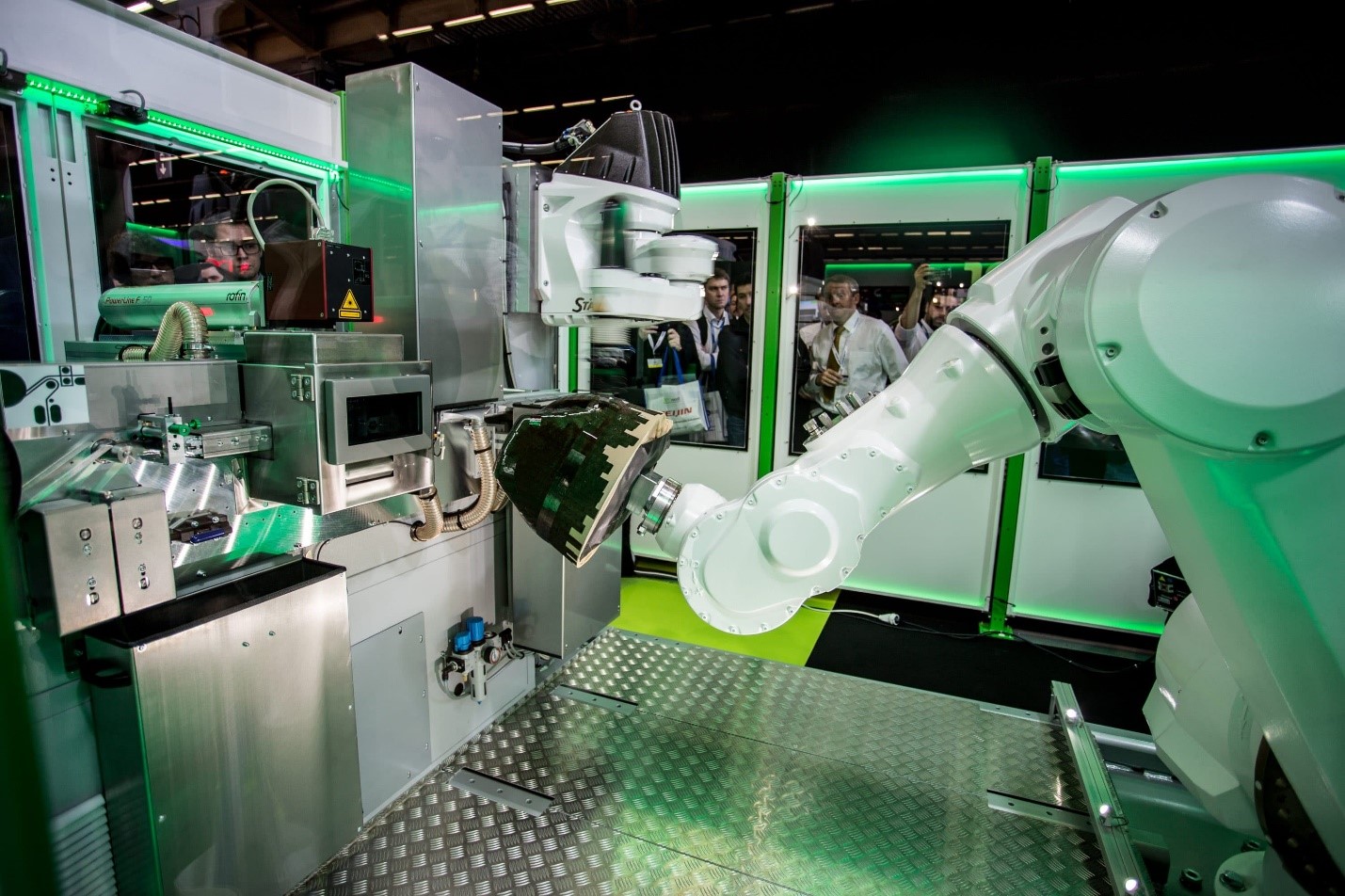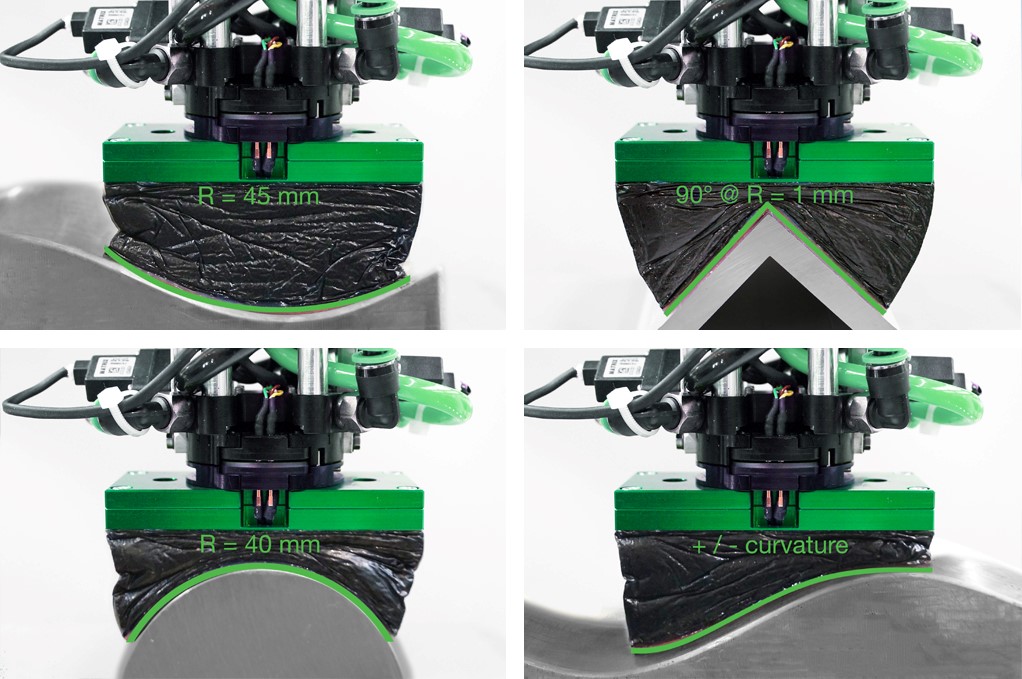Using Additive Manufacturing for Unprecedented Composite Design Freedom
Additive manufacturing has given designers a new level of creative freedom in developing new products to exacting specifications without limitations of traditional manufacturing processes. Following a patch-based laminate manufacturing approach, using defined fiber pieces instead of endless fibers, not only extends automated, direct 3D fiber deposition to complex geometries, but also significantly improves mechanical performance and saves material costs. The technology dedicated to additive fiber layup is called Fiber Patch Placement. FPP is ideally suited for the automated production of geometrically complex fiber parts and reinforcements. Using a flexible, automated process similar to 3D printing, components are additively generated from fiber patches.
Patches are cut from a tape and applied precisely on predetermined positions with a flexible patch gripper. This enables a new range of automated fiber layup applications. The key advantage of Fiber Patch Placement is the fiber orientation along curvilinear load paths to achieve an effective lightweight design and high mechanical performance.
The individual orientation of each patch according to the stress in the component significantly improves the mechanical properties such as stiffness and strength. Therefore, patch-based fiber structures can reduce the weight of products considerably while improving desired mechanical properties. But the virtual product development chain for these patch-based-laminates on spatial geometries is challenging.

Cevotec GmbH, based in Taufkirchen, Bayern, Germany, is a provider of smart production technology for complex fiber composites. The FPP specialists developed a patch-based FE-plugin in Altair HyperMeshTM, which they will be presenting at the JEC World international composites expo in Paris this March. This plugin allows users to generate a fully automated patch-based laminate based on geometry, position, and orientation of patches as exactly defined in their CAD-CAM software ARTIST STUDIO. The features of the plugin enable the modeling of the precise fiber orientation of each patch and even the thickness distribution due to gaps and overlaps. The plugin supports a variety of automated modeling approaches, including (thick-) shell-based laminates and even cohesive zone modeling for a detailed delamination analysis.
Dr. Neven Majic, Co-founder and EVP of Cevotec, states, “Altair and Cevotec’s CAE software helps to exploit the full potential of Fiber Patch Placement Technology. The Cevotec ARTIST STUDIO Plugin for Altair HyperMeshTM enables an automated modeling process of patch-based laminates and thus the simulation of the mechanical behavior of FPP lightweight design products! With the plug-in integration into HyperMesh the virtual process chain has been consequently extended. Applying this technology can save up to 50% on material cost and weight while significantly reducing development time.”

With this technology-specific virtual process chain approach of Artist Studio and the extension of HyperMesh, development cycles of cutting-edge lightweight FPP technologies can be significantly shortened, offering manufacturers the freedom to precisely fine-tune the performance and weight of their composite materials while bringing these innovative solutions to the market faster.
Dr. Neven Majic will be speaking at Altair’s conference “Empowering Composites Innovation with Simulation” at JEC World 2019.
Patches are cut from a tape and applied precisely on predetermined positions with a flexible patch gripper. This enables a new range of automated fiber layup applications. The key advantage of Fiber Patch Placement is the fiber orientation along curvilinear load paths to achieve an effective lightweight design and high mechanical performance.
The individual orientation of each patch according to the stress in the component significantly improves the mechanical properties such as stiffness and strength. Therefore, patch-based fiber structures can reduce the weight of products considerably while improving desired mechanical properties. But the virtual product development chain for these patch-based-laminates on spatial geometries is challenging.

Cevotec GmbH, based in Taufkirchen, Bayern, Germany, is a provider of smart production technology for complex fiber composites. The FPP specialists developed a patch-based FE-plugin in Altair HyperMeshTM, which they will be presenting at the JEC World international composites expo in Paris this March. This plugin allows users to generate a fully automated patch-based laminate based on geometry, position, and orientation of patches as exactly defined in their CAD-CAM software ARTIST STUDIO. The features of the plugin enable the modeling of the precise fiber orientation of each patch and even the thickness distribution due to gaps and overlaps. The plugin supports a variety of automated modeling approaches, including (thick-) shell-based laminates and even cohesive zone modeling for a detailed delamination analysis.
Dr. Neven Majic, Co-founder and EVP of Cevotec, states, “Altair and Cevotec’s CAE software helps to exploit the full potential of Fiber Patch Placement Technology. The Cevotec ARTIST STUDIO Plugin for Altair HyperMeshTM enables an automated modeling process of patch-based laminates and thus the simulation of the mechanical behavior of FPP lightweight design products! With the plug-in integration into HyperMesh the virtual process chain has been consequently extended. Applying this technology can save up to 50% on material cost and weight while significantly reducing development time.”

With this technology-specific virtual process chain approach of Artist Studio and the extension of HyperMesh, development cycles of cutting-edge lightweight FPP technologies can be significantly shortened, offering manufacturers the freedom to precisely fine-tune the performance and weight of their composite materials while bringing these innovative solutions to the market faster.
Dr. Neven Majic will be speaking at Altair’s conference “Empowering Composites Innovation with Simulation” at JEC World 2019.




